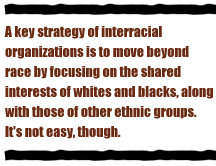In a growing number of city neighborhoods and rural districts around the country, people are
getting along -- and getting things done -- helping to combat previous
racial divisions in their communities.
For example:

These and other initiatives have thrown light on what some regard as a new breed of civic organization, one that crosses the color line in forging grassroots coalitions of common concern.
Many of the recruits in this movement -- which has spread to all parts of the country -- do not fit the popular activist stereotypes.
"We don't attract the Birkenstock liberals," said Mariba Karamoko, organizer of Shelby County Interfaith, an alliance of 48 Memphis congregations, half of them black, half of them white.
"These are people who haven't eaten a bit of tofu," he said. "They're middle of the roaders -- people who go to church every Sunday."
One of them is Ed Charbonnet, a computer analyst who got involved through his congregation, Holy Spirit Catholic Church, in white, affluent East Memphis. "I'm a card-carrying Republican. This is all new to me," he said.
Charbonnet was a leader in Shelby County Interfaith's successful drive for school-based management, or local control, and has pushed for new funds to repair rundown city schools.
He has also begun taking his daughter Clare, 12, along to meetings in black churches.
Citizens such as Charbonnet appear to be defying the odds at a time when polls show polarized black-white views of everything from the recent O.J. Simpson trials to public policy issues.
African Americans are three times more likely than the general population to see police brutality as a serious problem and are also far more likely to rate their local public schools as "only fair or poor" according to a survey taken last year by the Joint Center for Political and Economic Studies, a nonprofit research group in Washington.
"There has always been a wide gap between blacks and whites on critical issues," said Lee Daniels, spokesman for the National Urban League, based in New York. "The so-called racial divide is a fashionable phrase, but it's nothing new."
What's new, according to Daniels and other observers, is that ordinary black and white Americans are reaching for common ground in their communities, in apparently greater numbers than before.
"Those efforts are not reinforced by the larger society," he said. "There's very little notice given to them, and so you don't hear about them."
Behind some of the efforts are national networks such as the Industrial Areas Foundation, which organizes primarily among churches. Based in Chicago, the foundation counts 62 member organizations, representing congregations with more than 2.5 million families around the country.
The vast majority of the organizations are multiracial, according to Gerald Taylor, a national leader of the foundation who was the original organizer of Shelby County Interfaith.
Another network of this kind is the Pacific Institute for Community Organization, based in Oakland, Calif. Launched in 1972 as a regional coalition, the network has grown sixfold over the past decade.
It now represents 29 organizations, mostly church-based, in 60 cities as far east as Pensacola, Fla., and Brooklyn, N.Y., said the Rev. John Baumann, a Catholic priest who serves as the institute's executive director.
A key strategy of interracial organizations is to move beyond race by focusing on the shared interests of whites and blacks, along with those of other ethnic groups. "We organize around issues. That's the glue that holds people together," said Baumann.
It's not easy, though. In most places, bridging the racial gap means having to overcome deep suspicions and negative stereotypes, as well as vastly different perceptions of what ails the community, according to national leaders such as Baumann.
In Hartford, organizer Jim Boucher has seen Puerto Rican and Italian-American merchants slap each other on the back after winning a battle to keep city trash collection in their shopping districts. But he has also seen an accelerated process of white flight and urban decline.
"There's a lot of distress, and one (racial) group often blames the other group for things being so hard," said Boucher, whose organization is HART -- Hartford Areas Rally Together. "It's a big obstacle to racial harmony."
Still, many are hopeful.
A little over a decade ago, Bessie J. Smith wanted to help make Chattanooga "one of the greatest mid-size cities in the United States," as she put it. So did a few hundred others who met over Sunday brunches that launched the citizens' movement Chattanooga Venture.
"We had white folks and black folks putting their heads together," said Smith, an 81-year-old activist from the historic black Erlinger section.
From these sessions emerged the ideas for a downtown aquarium and scenic river park -- among other civic improvement projects that have become linchpins of Chattanooga's widely touted revival.
Posted July 7, 1997
Copyright ©1997 American News Service
[ Return to the Getting Along Cover Story ]
[News Archives |
Home & News ]
Copyright © 1998 Villagelife.org Inc. All rights reserved.